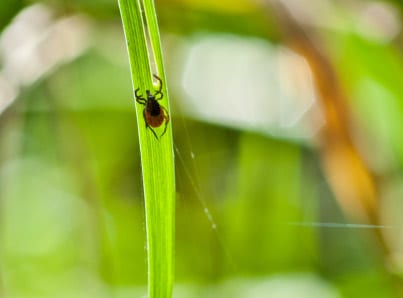
When we ask ourselves which ticks transmit Lyme diseaseThe first thing to know is that ticks are medium-sized arthropods about eight millimetres in size, although some species can reach a centimetre. Their biology is similar to that of spiders and scorpions. They are parasitic and feed on the blood of birds, reptiles and mammals. There are approximately 850 species of ticks in the world. Its presence is constant on all five continents and contact with humans usually occurs on field trips or through contact with some pets.
Do all ticks transmit Lyme disease?
Not all ticks transmit Lyme disease. There are a large number of tick species that do not transmit the disease. Examples include the lone star tick, the Canadian marmot tick and the Asian longhorned tick, but there are many more tick species in the world. The lone star tick is a tick that bites a lot and can transmit a number of diseases, not least Lyme disease. To find out if you have contracted Lyme disease, it is highly recommended that you get a Lyme disease testing.
For a tick to transmit Lyme disease through its bite, it must be infected with the bacterium Borrelia burgdorferi. It is time to ask what type of tick transmits Lyme disease.
What type of tick transmits it?
The type of tick that transmits this disease is the Ixodes scapulariswhich is also known as deer tick or blacklegged tick. This name has its origin in the fact that this type of tick usually parasitizes, especially in its larval stage, the white-tailed deer, even though can also be found in some rodents, reptiles and migratory birds...
Its presence is predominant in North America. It is one of the 36 species of ticks that can be found in this geographical area and it is estimated that this species accounts for 10 to 20 per cent of the ticks occupying the area..
The appearance of the deer tick varies according to sex. Females have four pairs of legs and are red and black in colour. Male Ixodes scapularis ticks are black. In their young age they are brownish in colour and their size is very small, making them very difficult to detect.
In addition, there are two variants of this tick that can also transmit Lyme disease are called Ixodes Ricinus and Ixodes Persulcatus.. The former is usually found in Europe and the latter in Asia.
Where is the tick that transmits Lyme found?
Lyme disease was first described in 1977 in Old Lyme, Connecticut, between New York and Boston. Although the disease has been found in Europe and Asia, it is most prevalent in the northwestern states of the United States.from Virginia to Maine, in the centrein Wisconsin and Minnesota and in the northern part of the west coast.
In Europe there is a variant called Ixodes Ricinus and in Asia there is Ixodes Persulcatus. These variants can also transmit Lyme disease. The Lyme-transmitting tick is most prevalent, however, in the United States and the disease is most frequently diagnosed there.
In terms of the physical place where they can be, it is very broad: ticks are usually found in places covered with low vegetation such as grassy fields, but also on bushes, trees and, of course, on animals.. Field trips, camping and living closely with pets that have access to outdoor areas can be risk factors.
As we have seen, the complexity of this disease is high. It requires an in-depth knowledge and understanding of details such as the one we have discussed in this article, which aims to make clear which ticks transmit Lyme disease. For this reason, it is always advisable to be as cautious as possible and, at the slightest suspicion, to contact professionals who can help us.
External sources:
FURMAN, D. P. & E. C. LOOMIS 1984. The ticks of California (Acari: Ixodida). Bulletin of the California Insect Survey. Volume 25. University of California Press, Berkeley. viii + 239 pp.
IO FOUNDATION: Information for health workers on ticks. Retrieved from https://fundacionio.com/salud-io/one-health/entomologia-para-todos/garrapatas/informacion-para-sanitarios-sobre-garrapatas/
MSD. Handbook for professionals. Lyme disease. By Larry M. Bush , MD, FACP, Charles E. Schmidt College of Medicine, Florida Atlantic University; Maria T. Vazquez-Pertejo , MD, FACP, Wellington Regional Medical Center. Medically reviewed Nov. 2020. Retrieved at https://www.msdmanuals.com/es/professional/enfermedades-infecciosas/espiroquetas/enfermedad-de-lyme

